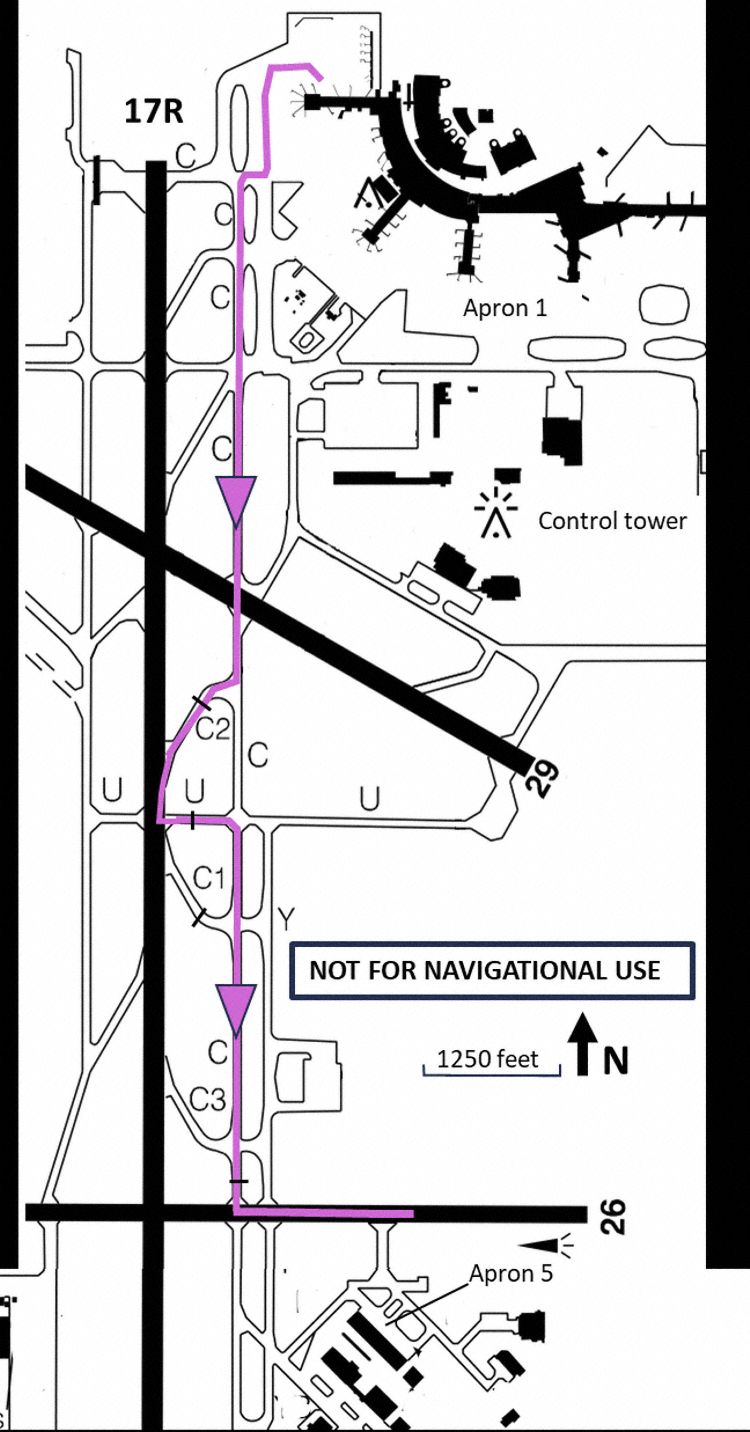A Jazz de Havilland Dash 8-400, registration C-GGNZ performing flight QK-7124 from Calgary,AB to Winnipeg,MB (Canada), was cleared for takeoff from Calgary's runway 17R, when a pair of tow tugs entered the runway. Tower instructed the crew to abort the takeoff, the instruction however was not heard by the crew. When the crew sighted the tugs they considered the safest option was to continue takeoff, the aircraft became airborne about 3700 feet short of the tugs and climbed over them at about 350 feet above them. The aircraft continued for a safe landing.
On Jul 22nd 2025 Canada's TSB released their final report concluding the probable causes of the occurrence characterized as a runway incursion with the risk of collision were:
Findings as to causes and contributing factors
- Due to procedural drift over time from an absence of recurrent training and oversight, the lead tug driver stopped too close to the Taxiway C2 runway holding position marking, which did not leave enough room for the vehicle to turn around as required by the AVOP Airside Traffic Directives.
- The ground controllers mental model was that the lead tug driver would continue the route the controller had instructed. This was contradictory to the lead tug drivers mental model in which the only way to continue the route was to enter Runway 17R; this mental model had been shaped, in part, by his proximity to the runway holding position. Consequently, the driver misinterpreted the instructions of the ground controller and entered Runway 17R while the departing aircraft was beginning its takeoff roll, resulting in a risk of collision.
Findings as to risk
- If the authority gradient between an air traffic controller and a ground vehicle operator is not proactively managed, a ground vehicle operator may not feel comfortable asking for clarification if he or she considers an instruction to be unclear or erroneous. This could potentially result in an operator taking actions that differ from those intended by an air traffic controller.
- If NAV CANADA relies primarily on additional time and aircraft spacing when A-SMGCS is disabled and key safety features are unavailable, there is an increased risk that hazardous situations such as runway incursions will occur and be detected too late to recover the situation.
- If air traffic controllers do not use the correct phraseology for safety-critical situations, there is a risk that the consequences of these situations could be more severe.
The TSB summarized the sequence of events:
Shortly before 1100 Mountain Daylight Time on 06 October 2023, 2 aircraft tow vehicles (tugs) (call sign ATSTOW504 +1) operated by Airport Terminal Services at Calgary International Airport (CYYC), Alberta, planned to drive from Apron 1, to the south side of the airport to reposition an aircraft that was parked on Runway 26. The lead tug driver was given instructions by the ground controller to proceed south on taxiways C, C1, and Y, and hold short of Runway 26. These instructions were amended shortly after with an instruction to enter Taxiway C2 to give way to an aircraft taxiing north, in the opposite direction, on Taxiway C. This communication included an instruction to hold short of Runway 17R, which the lead driver read back.
Once the taxiing aircraft had passed, the ground controller instructed the lead tug driver to continue on Taxiway C and hold short of Runway 26. The lead driver read back the instruction and, at 1104, both vehicles proceeded onto Runway 17R. At that time, another aircraft, a Jazz Aviation LP De Havilland Aircraft of Canada Limited DHC-8-402 operating as flight JZA7124, was beginning its take-off roll on Runway 17R. The aircrafts flight crew noticed the 2 tugs as the aircraft approached the decision speed (V1), but the flight crew elected to continue the takeoff. When the aircraft became airborne, it was approximately 3700 feet laterally away from the tugs. It then passed overhead the tugs and climb.
The path of the tugs (Graphics: TSB):

On Jul 22nd 2025 Canada's TSB released their final report concluding the probable causes of the occurrence characterized as a runway incursion with the risk of collision were:
Findings as to causes and contributing factors
- Due to procedural drift over time from an absence of recurrent training and oversight, the lead tug driver stopped too close to the Taxiway C2 runway holding position marking, which did not leave enough room for the vehicle to turn around as required by the AVOP Airside Traffic Directives.
- The ground controllers mental model was that the lead tug driver would continue the route the controller had instructed. This was contradictory to the lead tug drivers mental model in which the only way to continue the route was to enter Runway 17R; this mental model had been shaped, in part, by his proximity to the runway holding position. Consequently, the driver misinterpreted the instructions of the ground controller and entered Runway 17R while the departing aircraft was beginning its takeoff roll, resulting in a risk of collision.
Findings as to risk
- If the authority gradient between an air traffic controller and a ground vehicle operator is not proactively managed, a ground vehicle operator may not feel comfortable asking for clarification if he or she considers an instruction to be unclear or erroneous. This could potentially result in an operator taking actions that differ from those intended by an air traffic controller.
- If NAV CANADA relies primarily on additional time and aircraft spacing when A-SMGCS is disabled and key safety features are unavailable, there is an increased risk that hazardous situations such as runway incursions will occur and be detected too late to recover the situation.
- If air traffic controllers do not use the correct phraseology for safety-critical situations, there is a risk that the consequences of these situations could be more severe.
The TSB summarized the sequence of events:
Shortly before 1100 Mountain Daylight Time on 06 October 2023, 2 aircraft tow vehicles (tugs) (call sign ATSTOW504 +1) operated by Airport Terminal Services at Calgary International Airport (CYYC), Alberta, planned to drive from Apron 1, to the south side of the airport to reposition an aircraft that was parked on Runway 26. The lead tug driver was given instructions by the ground controller to proceed south on taxiways C, C1, and Y, and hold short of Runway 26. These instructions were amended shortly after with an instruction to enter Taxiway C2 to give way to an aircraft taxiing north, in the opposite direction, on Taxiway C. This communication included an instruction to hold short of Runway 17R, which the lead driver read back.
Once the taxiing aircraft had passed, the ground controller instructed the lead tug driver to continue on Taxiway C and hold short of Runway 26. The lead driver read back the instruction and, at 1104, both vehicles proceeded onto Runway 17R. At that time, another aircraft, a Jazz Aviation LP De Havilland Aircraft of Canada Limited DHC-8-402 operating as flight JZA7124, was beginning its take-off roll on Runway 17R. The aircrafts flight crew noticed the 2 tugs as the aircraft approached the decision speed (V1), but the flight crew elected to continue the takeoff. When the aircraft became airborne, it was approximately 3700 feet laterally away from the tugs. It then passed overhead the tugs and climb.
The path of the tugs (Graphics: TSB):

This article is published under license. Article Source
Published Date















